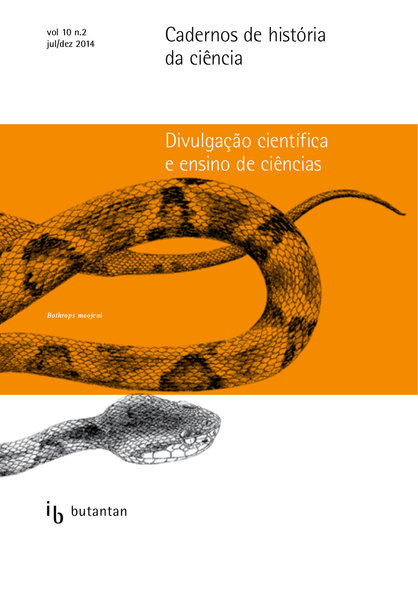Abstract
As part of my graduate diploma in Science Communication at Laurentian University, I explored how seven children’s books about the life of Galileo and Columbus framed science and religion. Using a rhetorical approach, I examined the text and images of the books to see if the books framed known or perceived conflicts between science and religion in a balanced frame, or if they were framed in an unbalanced opposition or non-oppositional way. Using Janis and Fadner’s coefficient of imbalance, I was able to quantify the results and found that the books tend to frame science and religion in a balanced way. However, the images in the sections of the books that dealt with known or perceived conflict between the Catholic Church and Galileo or Columbus strayed from a balanced view and framed science and religion as either oppositional or non-oppositional.
References
AR BookFinder. (2014). Retrieved June 13, 2015, from http://www.arbookfind.com/default.aspx
Armbruster, D., Suchert, V., Gärtner, A., & Strobel, A. (2014). Threatening shapes: The impact of simple geometric configurations on peripheral physiological markers. Physiology & Behavior, 135, 215–221.
Aronoff, J. (2006). How We Recognize Angry and Happy Emotion in People, Places, and Things. Cross-Cultural Research, 40(1), 83–105.
Bar, M., & Neta, M. (2006). Humans prefer curved visual objects. Psychological Science, 17(8), 645–648.
Consolmagno, G. (2000). Brother Astronomer: Adventures of a Vatican Scientist. New York: McGraw-Hill.
Cormack, L. B. (2009). That Medieval Christians Taught That the Earth was Flat. In R. L. Numbers (Ed.), Galileo Goes to Jail and Other Myths About Science and Religion (pp. 28–34). Cambridge, MA: Harvard University Press.
Crowley, S., & Hawhee, D. (2012). Acncient Rhetoric for Contemporary Students (5th ed.). New Jersey: Pearson Education.
Deephouse, D. L. (1996). Does isomorphism legitimate? Academy of Management Journal, 39(4), 1024–1039.
Ecklund, E. H., Johnson, D. R., Mamshari, S., Matthews, K. R. W., & Lewis, S. W. (2015). A Global Lab: Religion among Scientists in International Context. a conference report. Finocchiaro, M. A. (2009). That Galileo was Imprisoned and Tortured for Advocating Copernicanism. In R. L. Numbers (Ed.), galileo Goes to Jail and Other Myths About Science and Religion (pp. 68–78). Cambridge, MA: Harvard University Press.
Foss, S. K. (2005). Theory of Visual Rhetoric. In K. Smith, S. Moriarty, G. Barbatsis, & K. Kenny (Eds.), Handbook of Visual Communicatin: Theory, Methods, and Media (pp. 141–152). Lodon: Lawrence Erlbaum Associates.
Francis. (2015). Laudato Si’ [Encyclical Letter on Care for our Common Home]. Vatican: Vatican Press.
Gould, S. J. (1999). Rocks of Ages: Science and Religion in the Fullness of Life. New York: Ballantine Books.
Greenhaus, J. H., Collins, K. M., & Shaw, J. D. (2003). The relation between work-family balance and quality of life. Journal of Vocational Behavior, 63(3), 510–531.
Janis, I. L., & Fadner, R. H. (1943). A coefficient of imbalance for content analysis. Psychometrika, 8(2), 105–119.
Krippendorff, K. (2013). Content Analysis: An Introduction to Its Methodology (3rd Editio.). London: SAGE.
Larson, C. L., Aronoff, J., Sarinopoulos, I. C., & Zhu, D. C. (2009). Recognizing threat: a simple geometric shape activates neural circuitry for threat detection. Journal of Cognitive Neuroscience, 21(8), 1523–1535.
Mellor, F. (2009). Image-Music-Text of Popular Science. In R. Holliman, E. Whitelegg, E. Scanlon, S. Smidt, & J. Thomas (Eds.), Investigating Science Communication in the Information Age: Implications for public engagement and popular media (pp. 205–220). Oxford: Oxford University Press.
Numbers, R. L. (2009). Introduction. In R. L. Numbers (Ed.), Galileo Goes to Jail and Other Myths About Science and Religion (pp. 1–7). Cambridge, MA: Harvard University Press. O’Leary, Z. (2010). The Essential Guide to Doing Your Research Project. London: Sage.
Reiss, M. J. (2008). Should science educators deal with the science/religion issue? Studies in Science Education, 44(2), 157–186.
Salkind, N. J. (2010). Statistics for People Who Think They Hate STatistics (2nd ed.). London: Sage. Samuels, S. J., Biesbrock, E., & Terry, P. R. (1974).
The Effect of Pictures on Children’s Attitudes Toward Presented Stories. The Journal of Educaiton Research, 67(6), 243–246.
Singham, M. (2007). Columbus and the Flat Earth Myth. Phi Delta Kappan, 88(08), 590–592.
Sturken, M., & Cartwright, L. (2009). Images, Power, and Politics. In Practices of Looking: An Introduction to Visual Culture (2nd ed., pp. 9–48). Oxford: Oxford University Press.
Watson, D. G., Blagrove, E., Evans, C., & Moore, L. (2012). Negative triangles : simple geometric shapes convey emotional valence. Emotion, 12(1), 18–22
Zhihui Fang. (1996). Illustrations , Text , and the Child Reader : What are Pictures in Children’s Storybooks for ? Reading Horizons, 37(2), 130–141.
